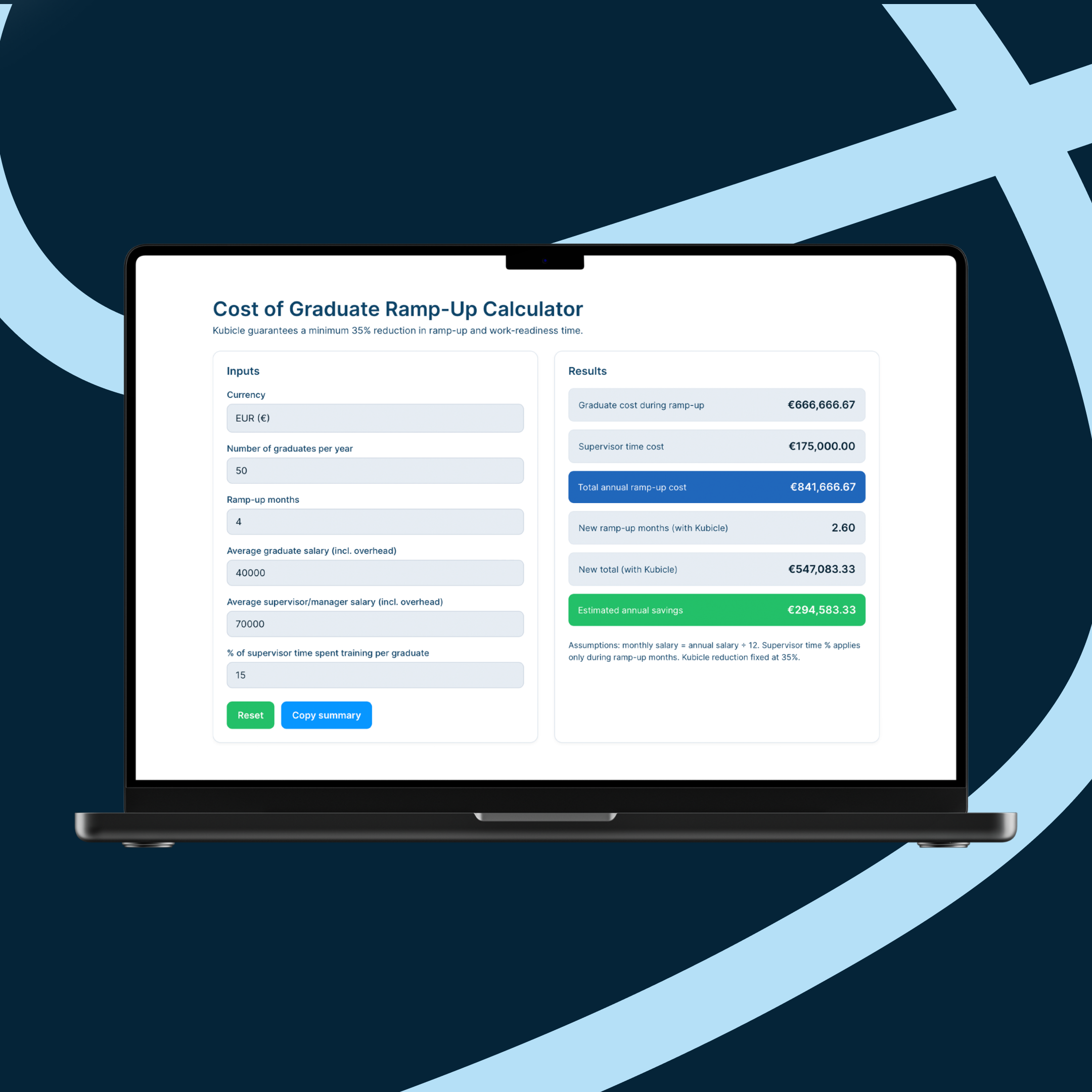The AI Skills Gap: The Missing Link Between AI Investment and Real Business Value
Most AI programs fail because of a skills gap, not technology. Learn how AI employee training programs drive productivity, reduce risk, and meet new compliance obligations, with a practical roadmap you can use today.
.png)
Speak to One of our Learning Consultants Today
Talk to SalesThe GenAI Divide Is a People Problem
Generative AI has rapidly become a fixture of everyday work. From marketing departments drafting content to finance teams automating reports, AI tools are now embedded across most organizations. Yet despite this widespread adoption, most companies still struggle to turn potential into measurable value. Billions have been invested, pilot programs abound, but for many, return on investment remains elusive.
The difference between the few organizations thriving with AI and the many that remain stuck in experimentation is deceptively simple. Successful companies invest systematically in AI employee training programs that close internal skills gaps and elevate overall performance. The evidence is striking: when professionals are trained to use AI effectively, their productivity on complex tasks can rise dramatically. By contrast, organizations that rely on unstructured experimentation find themselves trapped in low-impact pilots, producing uneven results and avoidable risk.
AI adoption, at its core, is not a technology problem. It is a human capital problem. Tools alone do not create transformation - people do. Training is the lever that converts AI’s promise into performance.
The Hard Numbers Behind the Business Case
Three forces make a compelling case for investment in structured AI employee training.
First is productivity. Analysts estimate that generative AI could add trillions of dollars in annual value to the global economy. Those gains are not theoretical. They are emerging now in core business functions such as customer service, marketing, banking, and retail, where AI is automating repetitive work and enhancing decision-making. The opportunity is already within reach for organizations prepared to scale it responsibly.
Second is talent. The market value of AI capability is growing at an extraordinary pace. Roles that require AI proficiency now command significant wage premiums, and that premium is widening. Upskilling employees has become a defensive strategy to retain ambitious talent who might otherwise leave for competitors offering higher pay and better learning opportunities.
Third is compliance. Regulators are moving from encouragement to enforcement. The EU AI Act, for example, requires organizations to ensure that staff operating or overseeing AI systems have adequate AI literacy. Training has therefore evolved from an optional development initiative into a legal and ethical responsibility. It is now a factor in assessing liability and the severity of potential penalties after an incident.
The Hidden Cost of Untrained AI Use
Many organizations underestimate the risk of letting employees “figure out AI on their own.” Untrained enthusiasm can create costly and reputationally damaging mistakes.
Data security is often the first casualty. Well-intentioned employees routinely paste confidential information - such as source code, financial models, or internal communications - into public AI tools. These leaks have already forced companies into reactionary bans and crisis management. A more sustainable solution is to teach employees how to use AI safely from the start.
A second danger is the phenomenon of “AI hallucination.” Generative models can produce plausible-sounding but incorrect or entirely fabricated information. Without verification processes, employees may act on these false outputs. The consequences are real: in one well-publicized case, an airline was held legally liable for an AI chatbot’s invented refund policy.
Finally, bias and overreliance can quietly erode judgment. AI systems trained on historical data can replicate discrimination in hiring, lending, or performance evaluations. Moreover, when employees grow too dependent on automated outputs, they risk losing critical thinking skills. Training programs must therefore go beyond how to use AI - they must teach when not to use it, and how to check its work.
In this sense, AI training serves both as a productivity accelerator and as an insurance policy against human error, data loss, and compliance failure.
Why Generic Training Fails
Despite the growing urgency, many organizations still approach AI training superficially. General “learn AI” courses may raise awareness, but they rarely change behavior or performance. What employees need instead is contextual, role-specific training that demonstrates how AI enhances their existing workflows.
A finance professional, for instance, benefits less from learning about language models in theory and more from mastering how to automate month-end close reports, forecast cash flow, or detect anomalies. A marketing manager gains more from understanding how AI can personalize campaigns or prioritize leads than from studying model architecture. Data analysts, meanwhile, must learn safe prompting methods - such as providing schema structures rather than real datasets - to maintain confidentiality while leveraging AI for speed and accuracy.
Context transforms knowledge into performance. Employees engage most when they can immediately apply new skills to the work already in front of them.
Building an AI Training Program That Works
Organizations that succeed in embedding AI literacy approach the challenge methodically. The first step is to measure before managing. A structured readiness assessment establishes a clear baseline of current capabilities, adoption rates, and risk behaviors. With this data, leaders can identify where to focus resources and which teams stand to benefit most from early training.
The second step is to translate these insights into a coherent, data-driven roadmap. Rather than treating training as a one-off course, leading companies integrate it into ongoing development plans tied directly to business outcomes. Programs blend conceptual lessons with practical exercises and sandboxed projects that mirror the organization’s real tools and data environments. Clear metrics track engagement, proficiency, and the impact on productivity or error reduction.
Crucially, good programs also include governance. Employees should understand not just what AI can do, but what guardrails apply to its use. Human-in-the-loop reviews, verification checklists, and privacy safeguards make AI adoption both faster and safer.
What Effective Training Looks Like
The most successful programs share a few defining traits. They teach workflows, not tools - helping employees master specific tasks rather than generic capabilities. They emphasize safe prompting and fact-checking habits that build trust in AI outputs. They define measurable success indicators, such as time saved on routine tasks or improvements in data quality. And they equip managers to reinforce best practices, creating a culture of informed experimentation rather than uncontrolled risk-taking.
The Kubicle Approach
Kubicle’s programs are built around these principles. They focus on measurable, role-specific outcomes and are tailored to real business functions in finance, marketing, analytics, and operations. Kubicle helps organizations establish a baseline through AI readiness assessments, design analytics-driven learning paths that adapt to individuals, and deliver contextual content aligned with the tools employees already use.
The Path Forward
The story of AI in business is not about technology - it is about people. The gap between stagnant pilots and transformative performance can be traced to a single controllable factor: workforce capability. Effective AI employee training programs close that gap, unlocking productivity, reducing risk, and strengthening compliance in an increasingly regulated environment.
The organizations that will lead in the years ahead will not be those that simply buy the latest AI tools. They will be those that invest in their people, teach them to use AI responsibly, and make intelligent technology a shared, organization-wide competency. In the age of generative AI, success belongs to the companies that make learning their competitive advantage.












